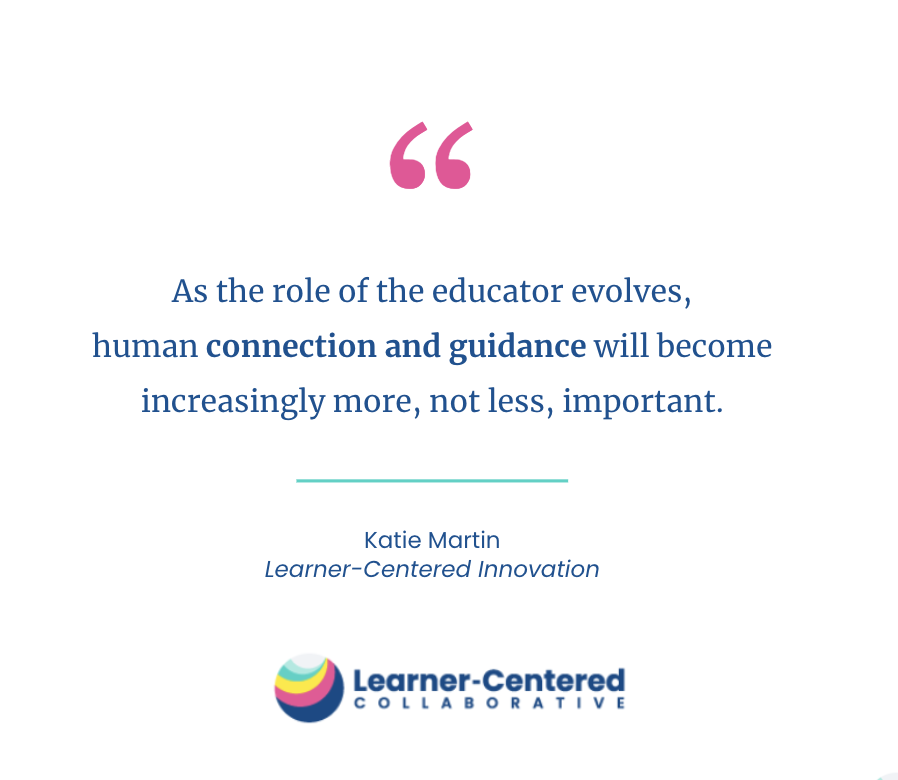In the last few years, especially as schools have navigated the pandemic, technology has become almost ubiquitous in schools. Curriculum, instruction, assessment, and communication are often facilitated by technology and tools. These tools can be powerful, and I believe a learner-centered approach that is personalized, competency-based, authentic, inclusive, and equitable requires technology to support the evolving role of the educator.
Like most practices, however, how the technology is used is critical to examine in service of our desired goals. If we aren’t intentional, the technology can be a digital worksheet limiting the power of the educator to connect with learners, provide feedback and guidance, and identify support needed in service of articulated learning goals.
I remember doing research in a district when they first went 1:1 with laptops for each student. We interviewed students, and while I expected them to be so excited to have access to technology and have more choice in their pacing and path, they said they missed interacting with the teachers. I was shocked.
I didn’t initially understand what they meant, but when I observed the classrooms, I realized what was happening. The curriculum was online, and the teachers began to monitor students’ work from behind their computers. The face-to-face interactions lessened as the digital assignments increased. On the surface, the “digital transformation” was a success. Teachers and students were online. The teachers were following the program guidance and had let the technology replace lectures and worksheets. The result was that students worked individually on their computers and communicated through chat with their teachers. Instead in empowering learners and leveraging teachers’ expertise, this created less interaction and decreased student investment (and likely the teachers too).
Although curricular programs have the capabilities of providing directions, lessons, and managing digital feedback and grading, it doesn’t mean it’s the best way to create meaningful learning experiences. The value of a teacher is in the ability to connect, guide, and coach learners, not simply monitor digital progress.
Intentionally Designed Experiences
I recently had Catlin Tucker on my podcast, and one of the many things I love about Catlin’s work is her approach to blended learning. It’s not focused on the tools or online curriculum, she begins with her learning goals and designs balanced opportunities for engaged online and offline learning.
The question should not be: “Do we use technology?” but instead, “How can we structure our time and tools to ensure that the learning experience allows students to develop expertise, deepen their thinking and get feedback that is personalized and authentic?” Technology alone will rarely suffice as I shared in Learner-Centered Innovation, “As the role of the teacher evolves, human guidance and connection matter more-not less- than ever.
Once learning plans are designed and students have clear criteria that they are working toward, leveraging technology for students to access resources, complete assignments, and work at their own pace, can allow you to shift from a standardized, whole-group lesson to more authentic, personalized, and competency-based pathways, while also freeing you up to connect and guide learners in new and different ways.
3 Strategies To Connect In Order To Provide Guidance for Learners
Greet students at the door
This is one of my favorite ways to connect with students. I always greeted them at the door so I could say hi, see how they were as they entered, and build the connection. Making a personal connection to start each class helped me maximize the time we had in class. This has nothing to do with technology- it’s just good practice and can help you determine where to direct your energy during class.
Mini Conferences
Meeting individually with learners is likely impossible when most of your time is spent teaching the lesson to the whole group. When you make resources available using technology, you can use class time for learners to get what they need. Then you can use the time when students are working to conference with students in to provide feedback, check in on progress, celebrate their growth, or take a pulse on how they are and use it as an opportunity to build a relationship that will make the student feel seen and valued.
Small Groups
Pulling small groups based on interests, goals, current achievements or needs is a great way to get some quality face time and also see what students know and can do, teach a mini-lesson that is targeted or gather feedback.
Technology can help learners take ownership of their journey and drive their learning in and beyond the classroom walls. Technology cannot replace a teacher who knows their students, builds relationships, pushes them to the next level, and creates a community where students feel like they belong. Being intentional about which tools we use and how to leverage the best of both human capacity and technology is foundational to creating the most meaningful learning experiences for our students.



0 Comments